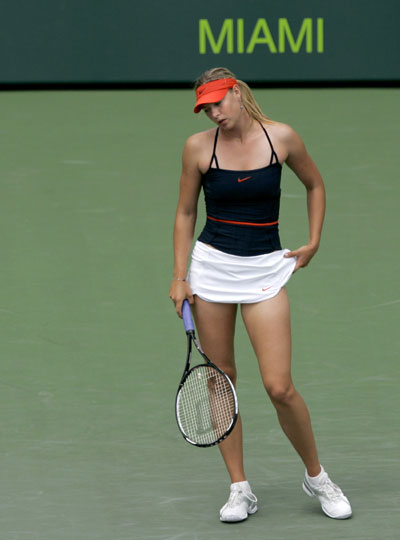Tennis
Sharapova's serve goes south
(ESPN)
Updated: 2007-03-28 10:41
 |
Large Medium Small |
 Maria Sharapova reacts after losing a point against Serena Williams of the U.S. at the Sony Ericsson Open tennis tournament in Key Biscayne, Miami March 27, 2007. [Reuters]  |
At the Sony Ericsson Open in Key Biscayne, Fla., on Sunday, it was painful to watch Sharapova slog her way through a three-set victory over Venus Williams in the third round. The match, marred by a high number of unforced errors on both sides of the net, saw Sharapova commit 13 double faults. She also won a paltry 38 percent of her points on second serve.
Things got worse in the next round against Serena Williams. Granted, this was an unkind draw for Sharapova, but she was routed. Much of the 6-1, 6-1 loss had to do with her serve. The stats are ugly: Sharapova hit eight double faults, and won just 50 percent of her points on first serve and 25 percent on second serve (compared to Serena's 80 percent on first serve and 61 percent on second).
What the numbers don't show is the pained look on Sharapova's face after one errant serve was on its way into the wrong service box before mercifully hitting the net. The stats also fail to illustrate when Sharapova threw in a short second serve or, playing it safe, an off-speed first one. These weak deliveries allowed Serena to play tee ball and put Sharapova on the immediate defense.
Defense is not Maria's forte.
No other shot in tennis tells so much about a player's mental state than the serve. It's a confidence stroke. When you lose faith in it, well, recreational players can relate. Your arm gets heavy, as if it's a burden to raise it up over your head. Your legs turn into cinder blocks, as if Tony Soprano is about to throw you into the East River. You try for softer first serves, harder second ones -- anything to break the funk -- with usually disastrous consequences.
Practice? It won't do you much good once the match starts and you hit that first double fault and the doubts start creeping back in. Just ask Anna Kournikova, whose serve could go off the deep end quicker than Britney Spears on a bender in Vegas. (Special K once hit a not-so-special 31 double faults in a match at the 1999 Australian Open.) Just ask Elena Dementieva, who has been among the elite players despite one of the tour's weakest deliveries.
Come to think of it, maybe the serving yips are a Russian thing. Bada bing. Or a blonde one. Bada boom.
Seriously, though, when Sharapova won last year's U.S. Open, it was a turning point for her. She was no longer a one-Slam wonder. It was a huge step forward, and the question turned to whether she'd start a nifty collection of Grand Slam trophies. Then her serve went into the witness protection program.
All is not really lost: She's still competing ferociously, and the rest of her game is sharp. She's good enough to get by most opponents, even on a bad serving day. It's the players with the intimidating returns who will be an issue for her. Can she get her mind straight to straighten out her serve? That's the big question facing Sharapova now.
| 分享按钮 |